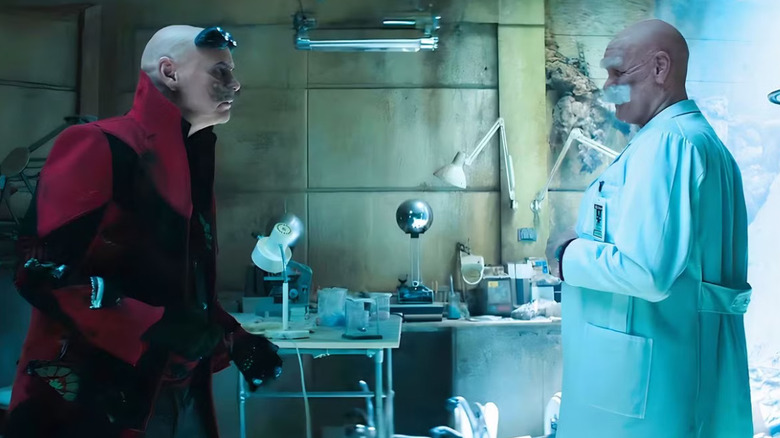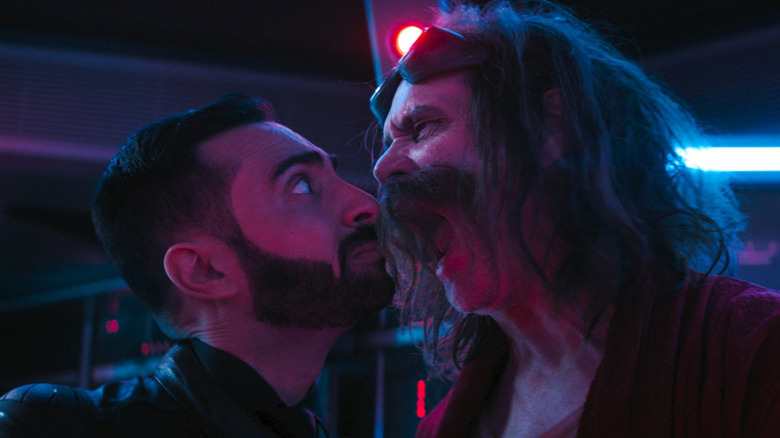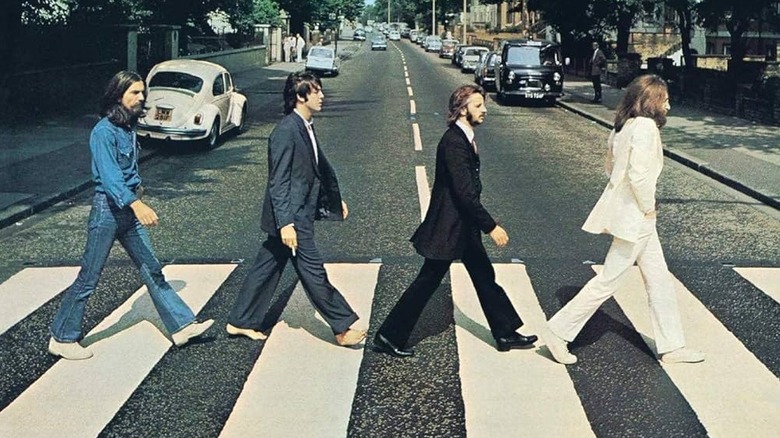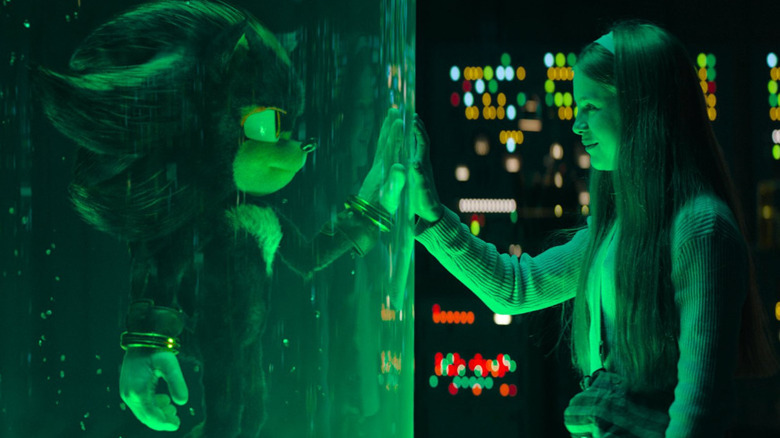Things Only Adults Noticed In Sonic The Hedgehog 3
Contains spoilers for "Sonic the Hedgehog 3"
Movies based on video games don't exactly have the greatest reputation ... and, honestly, for good reason. Some of the worst movies ever made were adaptations of video games. However, a recent surprise was the overwhelmingly positive reception to the "Sonic the Hedgehog" films, which is a video game franchise that — while popular in the mid-to-late '90s — wasn't exactly at its peak prior to the first film's release. Compounding the surprise was the tumultuous pre-release marketing, which included the infamous "Ugly Sonic" trailer that was rightly mocked for its creepy and unsettling design.
However, despite all that, the live-action/CG-hybrid "Sonic the Hedgehog" film was a box-office success, earning $300 million dollars at the global box office. The film stars Ben Schwartz as the voice of the titular blue hero, alongside Jim Carrey as the villainous Dr. Robotnik in full manic '90s comedy mode.
The film's success earned the "Sonic" film a sequel in 2022 — the aptly-titled "Sonic the Hedgehog 2" — which was not only a bigger commercial success than the first film but a critical success as well, becoming one of the few video game movies to be granted a "certified fresh" rating. And, due to both of the films' success, "Sonic the Hedgehog 3" was released, with Keanu Reeves voicing fan-favorite Shadow the Hedgehog and Carrey doing double-duty as Robotnik and Robotnik's own grandpa, Gerald.
But, despite being a children's film, there are some elements that only adult fans would appreciate, such as double-entendres, references to old game cartridges, and more below!
Blowing on SEGA Genesis cartridge referenced
Before the final act of the film, Sonic requests that his adopted human parents Tom and Maddie Wachowski (James Marsden and Tika Sumpter, respectively) help them break into G.U.N. headquarters in London to stop the Robotniks' and Shadow's plan of world destruction. Tom and Maddie need to get to the HQ's server room to turn off an energy force-field that is preventing Sonic from entering himself. Once in, they must then insert a special USB thumb drive into G.U.N.'s main server given to them by Tails, to grant him access to G.U.N. HQ's security system. However, the USB drive doesn't work. Tom then gets the idea to blow into it ... annoying Tails in the process, who claims there's no evidence that will fix anything.
But after Tom blows on it, he sticks the USB stick in the server, and Tails gets access. This is obviously a reference to the 16-bit era of gaming from the '90s, where it was assumed that blowing underneath the cartridge would help start a game that wasn't booting, though — as Tails says in the film – there's not much evidence that's actually true. This reference is especially fitting, since Sonic first appeared on the 16-bit SEGA Genesis console in 1991, with Maddie even exclaiming "the '90s were the best decade" to Tom, as if to drive the point home.
This is also something younger generations will not be privy to, given how everything is either disk-based, downloadable, or — in the case of the Nintendo Switch — uses SD cards.
Dr. Robotnic makes a manscaping joke
The climax of the "Sonic the Hedgehog 3" film takes place on a giant space weapon called the "Eclipse Cannon," where Shadow and Gerald Robotnik plan on using the station's world-ending laser beam to destroy the Earth as revenge for the death of Maria Robotnik fifty years ago (the event that is the cause of Shadow's iconic dark brooding).
Dr. Ivo Robotnik, once finding out the plan, is much less on board with it than the other two are — especially since it's a suicide mission for both Gerald and Shadow (and, unwittingly, Ivo as well). This leads to a fight between grandfather and grandson, where the two Robotniks fight with high-tech inventions against each other for control of the space station and world-ending weapon.
During the fight, Gerald reveals cyber-scorpion attachments, while Ivo unveils cyber-mantis arms. Eventually, Ivo uses his cyber-mantis claws to cut off a part of Gerald's whitened iconic Robotnik 'stache, with Ivo quipping that he's doing some "mantis-scaping." Now, "mantis-scaping" is obviously a pun on the term "manscaping," which, in essence, is just male shaving and grooming. Thus, the quip is apropos, as Ivo had just cut off half Gerald's elongated mustache. However, "manscaping" as a term also colloquially refers to the shaving of men's pubic hair. With this in mind, that makes the "mantis-scaping" joke more than a bit risqué of a reference for an ostensible children's film ... but at least it's hidden well within the insect pun.
Gerald Robotnik's old-timey and outdated sexism
As Team Sonic and their human allies attempt to infiltrate G.U.N. headquarters, Ivo and Gerald Robotnik are doing the same to steal one of two key cards that will get their world-ending Eclipse Cannon weapon up-and-running. After an (honestly, over-extended) dance sequence between Ivo and Gerald Robotnik as they use their specially-designed black-and-red spandex suits to deflect the otherwise dangerous laser-security system, they finally reach the secret G.U.N. vault with key card. Unfortunately, Ivo and Gerald are caught in a variable gravity room, possibly referencing one of the later levels in 2001's "Sonic Adventure 2" for the SEGA Dreamcast.
While introduced earlier in the film as a G.U.N. agent who distrusts Sonic and his anthropomorphic alien friends, this is the first time the Robotniks meet the stern and intense Director Rockwell (Krysten Ritter), who like the other G.U.N. agents, is decked out in black, tactical military gear.
This is when the geriatric Gerald Robotnik — apparently 104 years old, kept alive by siphoning the energy from one of Shadow's glowing quills he plucked right before he got arrested — exclaims incredulously "Wait, women in the military!" at Rockwell. And while the line from Gerald is played for laughs, it's obvious that Gerald is the butt of the joke for his out-of-touch sensibilities (exacerbated by having been incarcerated for 50 years). It's also something kids probably won't catch, given how long women have been actively in the military, and how they've been regularly depicted in media for decades now.
Dr. Ivo Robotnik – refreshingly – acknowledges all genders
Dr. Ivo Robotnik is not in great shape when we first meet him in "Sonic the Hedgehog 3." At the end of the second "Sonic" film, it seemed that he had been killed off for good when his giant Eggman robot exploded after fighting the glowing yellow "Super Sonic." Luckily for us (since it means more manic Jim Carrey), but unfortunately for Sonic, Ivo survived that defeat, and is currently living in an underwater robotic crab lair. There, Ivo is eating himself to obesity (finally looking more like his rotund video game counterpart) and getting obsessed with a steamy telenovela called "La Ultima Pasión" — starring Ted Lasso's Cristo Fernández — which was first introduced in the "Knuckles" streaming series for Paramount+.
Eventually, Agent Stone brings Sonic and his friends to Robotnik's underwater lair — since they were all recently attacked by Robotnik's robot drones — as Stone attempts to clear Ivo's name. Turns out that Robotnik was in fact not behind the attacks, and an imposter had been using his technology. Robotnik then offers to help Sonic, despite how Sonic has ruined his life, and that no one "from any gender" wants to have him at this point.
This line about "all genders" is refreshingly progressive coming from Dr. Robotnik, implying that a) he's pansexual, and b) that he's more open-minded than many politicians in Washington, D.C. The line is spoken quickly, though, and it'd be easy for most kids to miss this implication entirely.
Agent Stone's possible unrequited love with Dr. Robotnik
Agent Stone, played in all three "Sonic the Hedgehog" films by actor Lee Majdoub, is Dr. Ivo Robotnik's loyal (and only) henchman. Despite being a more than capable fighter, marksman, technician — and even tailor — Stone nonetheless is still confusingly, and unwaveringly, loyal to the emotionally abusive Dr. Robotnik. This is even more confounding as for most of the films, Ivo doesn't seem to show Stone much respect at all. In fact, the moment Gerald Robotnik comes into Ivo's life, Stone is immediately fired and kicked to the curb (though how, and if, Stone even gets paid is left ambiguous).
However, as the series goes on — and especially in the third film — there are indications that Stone's devotion is more than just professional. In fact, there were hints of it in the first film as well, which fan fiction authors and shippers have glommed onto immediately. Thing is, most loyal henchmen in media are usually gruff and stupid like Bebop and Rocksteady from "Teenage Mutant Ninja Turtles," where the main villain can easily manipulate them, or smart and conniving like Starscream from "Transformers," who see themselves as the rightful heir. Very rarely are henchmen smart, cunning, and loyal ... unless they're romantically-involved, like Joker and Harley Quinn from "Batman" or Destro and The Baroness in "G.I. Joe."
This, of course, is never made explicit in the Sonic films, so it's easy for kids — and even adults — to miss.
The Beatles' Abbey Road reference in London
Since the G.U.N. headquarters is located in London, in order to save the world from Shadow the Hedgehog and the Robotniks, Sonic and his team must infiltrate the aforementioned military base, which takes them straight to The Big Smoke in Great Britain.
At one point, Maddie and Tom are compromised, and Sonic has to speed up and enter the facility before a red force-field surrounds the building and makes infiltration impossible. However, since he's in London — and he's Sonic — the blue, bit-prone hedgehog decides to use his super-speed to do some pop culture bits along the way. This includes stealing crowns and jewelry from the palace, altering the appearance of the British royal guards, and recreating The Beatles' classic "Abbey Road" album cover, using his immense super-speed to create four afterimages of himself in the poses of "George, Paul, John ... and the other one." Poor Ringo.
Now, we're not saying no kid has ever heard of The Beatles (given how significant they are as cultural icons, and how presumably many parents and grandparents still gush over them); however, they're not as ubiquitous as they used to be. Which makes sense, as nothing stays super popular forever, and tastes change more drastically as more generations come and go. However, even kids who might catch Beatles songs through their musical algorithms might not immediately clock a reference to a decades-old album cover — even an eminently iconic one like "Abbey Road."
Shadow's flashbacks with Maria are set in the 1970s
It's mentioned throughout 2024's "Sonic the Hedgehog 3" that Shadow the Hedgehog had been imprisoned by G.U.N. and stuck in suspended animation on a remote prison island off the coast of Japan for 50 years. This means that his imprisonment began right around 1974 (if our basic math is correct). This is made even more explicit when we meet the 12-year old Maria Robotnik (Alyla Browne) — Gerald Robotnik's granddaughter — in Shadow's flashbacks, who becomes his only friend in the G.U.N. military research facility.
We can tell by her fashion sense alone that she's a child of the '70s, since Maria wears gaudy wool sweaters, bell-bottom jeans, and has an inclination towards roller skates. We can also tell by the music she shows Shadow, with her playing him a record of the song "End of the Line" by The Traveling Wilburys (her use of vinyl and a record player is another tell).
While all these decade-specific visual cues are obvious to an adult, they're probably less so with kids who don't have that frame of reference. Heck, even "That '70s Show" is pushing 30 years old at this point. Though it is surprising how there is no super-title or caption to confirm the date of the flashbacks, which is an odd choice for a kid's film.
Scientific issues with destroying the moon with a laser
Towards the end of the film, Gerald Robotnik is nearly successful in sending the Eclipse Cannon's world-destroying laser to Earth to finally destroy it ... until Sonic and Shadow — having both turned into their "Dragon Ball Z"-esque glowing "super" modes — fly in space to stop the beam from impacting Earth, literally with their bare hands. However, the laser is too strong to hold onto long, even with their strength infused by the Chaos Emeralds. So, Ivo Robotnik and Tails — who had found his way onto the space station at that point — attempt to steer the shooting laser beam away from Earth. In the process, however, the beam cuts through the moon like a knife, seemingly cutting it in half.
Now, this sequence is played up as a joke, and it is implied Earth is saved. However, it would be a catastrophic event if something like this were to happen to the moon. We would likely see pieces of moon debris falling to Earth like devastating meteorites and destroying cities, tidal waves shifting and causing tsunamis and flooding, mass extinction events caused by extreme weather changes, etc.
Sure, Gerald Robotnik's Eclipse Cannon didn't destroy the Earth in one go ... but if scientists are to be believed, that might've been the preferable outcome to what will actually happen after Sonic and Robotnik "saved the world." Best not to think about it, we suppose.
Family drama of fake soap opera parallels The Robotniks
Earlier, we brought up Dr. Robotnik getting obsessed with the Mexican soap opera "La Ultima Pasión," which seems like just a funny, random joke and reference to the "Knuckles" streaming show, but there's actually more going on. In "Sonic the Hedgehog 3," we see multiple scenes of the telenovela at different points throughout the film, and all of them deal with two brothers — both played by Cristo Fernández — fighting for the affections of the same woman. At one point, this leads to a duel to the death to see who she will end up with.
This mirrors the familial betrayal at the heart of Ivo Robotnik and his genocidal grandfather Gerald. While their conflict doesn't directly tie into fighting over a woman the way "La Ultima Pasión" does, their familial struggle still nonetheless concludes with a literal duel to the death. It's eventually revealed during the climax that Gerald had betrayed his grandson, and was only using Ivo to steal his advanced tech in order for Gerald to fulfill his own vengeful desires against the world. The final fight between the two Robotniks then leads to Ivo killing Gerald by sending him into an energy field.
However, a lot of that will go over a kid's head. They might laugh at the ridiculousness of the telenovela's over-the-top acting, and the randomness of Ivo watching it, but probably won't clock the thematic resonance ... or the incestuous undertones of the show's three-way romance.
G.U.N. as example of government overreach and corruption
G.U.N. is an acronym that stands for "Guardian Units of Nations," which is a multi-national military organization in the "Sonic the Hedgehog" franchise that was first introduced in the game "Sonic Adventure 2" for the SEGA Dreamcast. It's the organization that funded Gerald Robotnik's project studying Shadow the Hedgehog in order for them to exploit Shadow's power as an energy source or weapon. This all, of course, backfired, leading to the death of Maria Robotnik, the arrest of Gerald, and the imprisonment of Shadow the Hedgehog.
However, all this brings up a lot of uncomfortable questions. How is G.U.N. funded? It seems to mainly be headed by U.S. military personnel, despite its headquarters being located in London, England. Is it funded by the U.N.? N.A.T.O.? Do taxpayers have a say in how the funds are allocated? Could G.U.N. pass an audit, given the advanced tech it uses, and the research and development that would be necessitated for it? Worse, is it privately-funded? In that case, there would be much less regulatory oversight, though taxpayers would most likely still have to supplement their funding nonetheless.
To be clear, this is an issue with a lot of fictional universes, but it's still something that is too prevalent in children's media. It gears children to accept exuberant resources being given to the military for "cool tech" and the "common good" that could instead go towards social safety nets, education, and infrastructure.










